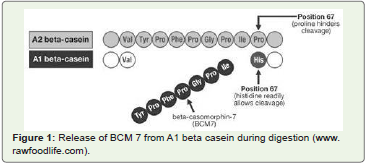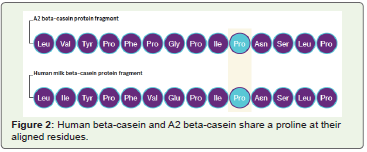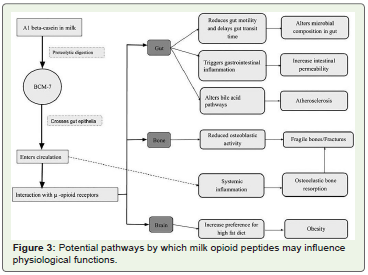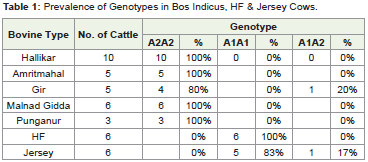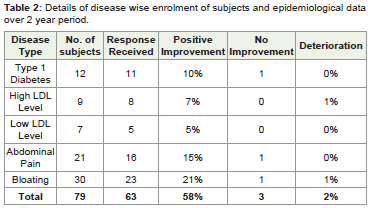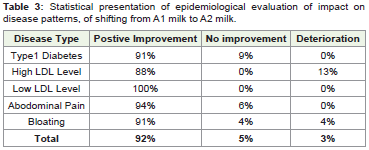Review Article
The Science of A2 Beta Casein - A Critical Review of Global Data and Outcomes of Indian Study
Pranesh Sridharan1* and Chidananda BL2
1Mathruka Cattle Farm & Research Center, India
2Department of Animal Sciences, University of Agricultural Sciences, GKVK, Bangalore, India
*Corresponding author: Pranesh Sridharan, Mathruka Cattle Farm & Research Center, Bengaluru, India; E-mail: dr.pranesh@gmail.com
Article Information: Submission: 07/01/2020; Accepted: 15/02/2020; Published: 18/02/2020
Copyright: © 2020 Sridharan P, et al. This is an open access article distributed under the Creative Commons Attribution License, which permits unrestricted use, distribution, and reproduction in any medium, provided the original work is properly cited.
Abstract
Milk provides wholesome nutrition, rich in proteins, vitamins and calcium. Recent research has shown milk to be a risk factor for diseases as well. The new
insights on A1 and A2 Beta-Casein proteins in milk has triggered significant interest globally in A2 milk, which is considered safe.
This is a first comprehensive Indian study on A2 and A1 milk, encompassing review of published literature, genetic study of cattle in India and impact of
A1 and A2 milk on health of individuals.
Review of over 60 published in-vivo, in-vitro and epidemiological studies indicate that A1 Beta-casein triggers the opioid peptide cascade, leading to
endogenous production of the opioid peptide BCM-7, that aggravates the risk factors of Type 1 Diabetes, IDDM, CHD, Autism, neurological disorders and
hormonal imbalances.The risks associated with A1 protein have not been associated with A2 beta-casein. Studies also indicate the presence of A2 beta-casein
in Bos Indicus cattle. Yield of BCM-7 from A1A1 milk was observed to be almost 3.2 times more than A1A2 variant of β-casein. However, release of BCM-7/5
could not be detected from A2A2 variant of β-casein. Genetic testing of 7 types of bovine cattle breeds was done in Mathruka Cattle Farm & Research Center,
including 5 Bos Indicus breeds, HF & Jersey. The results of the genetic study show the presence of 100% A2A2 genotype in Bos Indicus cattle including
Hallikar, Amritmahal, Malnad Gidda and Punganur. Gir had mostly A2A2 genotype with one cattle expressing A1A2 genes. HF had 100% A1A1 genotype
and Jersey had predominantly A1A1 genotype, with one cattle expressing A1A2 genotype. In the third part, an epidemiological survey in 79 subjects over
2 years period, showed a significant positive impact of A2 milk on health conditions such as Type 1 diabetes, cardiovascular diseases and Gastro-intestinal
disturbances including bloating and indigestion.
This study in Mathruka, shows that while A1 milk is associated with risk factors of diseases in children and adults, A2 milk has been proven to be safe.
The study also confirms the presence of pure A2A2 genotypes in Indian Bos Indicus Cows.
Keywords
A2 protein; BCM-7; A2 milk; Beta casein; Beta caso morphine; Opioid peptide; Bos indicus; Zebu
Introduction
In India milk has been considered as perfect food for ages. Milk
and milk products such as clarified butter have been part of ayurvedic
preparations since Vedic period. Milk is an important source of
nutrients and micronutrients. Milk consists of about 87 percent water
and 13 percent of milk solids constituting fat, lactose, minerals and
protein. Casein is the chief component of the milk proteins of which
about 30-35 percent is beta-casein [1].
Beta- casein may be of different types based on genetic background
of the animals but the major types are A1 and A2. Beta-casein consist
a chain of 229 amino acids.
Cows producing A2 milk are known as A2 cows while those
producing A1 milk are called A1 cows. Indian Bos Indicus Cows like
Hallikar, Malnad Gidda, Punganur, Amritmahal, Gir and Sahiwal
produce A2 milk, while Holstein (HF) and Ayrshire cattle breeds
predominantly produce A1 milk.
The distinguishing structure between the 2 forms of b-casein
is the presence of either histidine (His67) in A1 or proline (Pro67)
in A2 at position 67 of this 209-amino acid protein, with A1 being
consequential to a point mutation from Pro67 to His67 occurring in
ancestors to modern European-type cattle. Consequently, the milk
produced commercially in many countries contains a mixture of A1
and A2. The His67 mutation is absent in purebred Asian and African cattle (Bos Indicus Cattle - Hallikar, Malnad Gidda, Punganur,
Ongole, Gir, Sahiwal, Sindhi being the prominent ones). Similarly,
the presence of a histidine mutation at the equivalent position in other
mammalian species, including humans, is either absent or extremely
rare. (Human milk and Bos Indicus milk have similarities in Casein
structure). Within modern European-type cattle, there are additional
derivative b-casein proteins through mutations at other points of the
protein chain, which can be grouped within the A1 and A2 types. The
most important of these is type B b-casein, which, like A1, contains
His67. Other A1and A2 caseins can be considered minor. Most
studies are not explicit as to the presence or absence of these minor
variants and refer only to either “A1” or “A2” (Figure 1) [2].
In this review, we use the terminology of A1 and A2 as two major
classifications. Although His67 within A1 is susceptible to proteolytic
cleavage, Pro67 within A2 is not. Thus, A1s have the potential to
release short Beta-Casomorphin (BCM) opioid peptides, including
BCM-7, during gastrointestinal digestion. The avoidance of A1 is
feasible within dairy-based diets through the consumption of milk
from the native Indian cows. Bovine milk that is free of A1 is now
available commercially in a range of countries, including Australia,
the United Kingdom, the United States, New Zealand, and The
Netherlands, and is widely promoted as beneficial for people who
suffer from milk intolerances. Infant formula containing casein but
free of A1 is now marketed widely in China and Australia and is
promoted commercially as being more gentle on the infant digestive
system.
As per literature review available, this would be the first broad based critical review from India to evaluate the benefits of A2 milk and the harmful effects of A1, including Indian epidemiological and in vitro data.
Genetics behind A1 and A2 Milk:
Production of A1 or A2 milk by cows is governed by beta casein gene which is located on chromosome number 6. Since long back, cows have been producing A2 milk which is regarded as safe and nutritious. Beta-casein gene was mutated and 67th amino acid was changed from proline (A2 allele) to histidine (A1 allele). A cow carries
only two copies of the beta-casein gene. Hence, possibly she can be of A2A2 homozygous genotype or A1A2 heterozygous genotype or A1A1 homozygous genotype. The alleles do not have dominant - recessive relationship i.e., both the alleles are co-dominant in nature. Thus, an A1A2 cow will produce both A1 and A2 beta casein alleles in equal proportion. An A2A2 genotype cow will only produce A2 betacasein and an A1A1 cow will only produce A1 beta-casein. A cow of A2A2 genotype will transmit the A2 allele to her progeny while an A1A1 cow will pass on the A1 allele and for A1A2 cow there is an equal chance of transmitting either allele. Breeding for A2A2 cows can be done by using semen from bulls of A2A2 genotype [3].Notably, human beta-casein and A2 beta-casein share a proline at their aligned residues (9), which highlights that human beta-casein is of the A2 beta-casein type and not A1 (Figure 2).
Effect of Digestive Enzymes of A1 & A2 Milk:
Digestive enzymes act differently upon A1 and A2 beta-casein
proteins during digestion process. Beta-Casomorphin-7 (BCM-7)
a bioactive seven-amino peptide is released by digestive enzymes
from the A1-beta-casein protein but these enzymes cannot split the
A2 protein due to presence of proline at that location. So BCM-7 is
not released from A2 proteins digestion. BCM-7 interacts with the
human gastrointestinal tract, internal organs, and brainstem [1,4,5].Potential harmful effects of A1 Milk:
Several research workers have reported about the health hazards
associated with A1 milk consumption. It was observed that Polynesian
islands consuming only to A2 type milk were at lesser risk to Diabetes
type 1 than Polynesian children in Auckland who were accessing A1
type of milk.An in vivo experiment on non-obese diabetic found a positive
correlation between consumption of the β-casein A1 variant and
incidence of diabetes mellitus. BCM-7 can affect many opioid
receptors in the nervous, endocrine and immune system [6].
Infants are more vulnerable because they have more chance
of absorption of BCM-7 because of comparatively less developed
gastro-intestinal tract than the adults [7]. BCM-7 may act as an
immunosuppressant and may increase the risk of Type 1 Diabetes,
Coronary Heart Disease, Arteriosclerosis, and Sudden Infant Death
Syndrome. It is also related with some neurological disorders like
Autism or Schizophrenia [8-11].
Beta-casein A1 is more atherogenic than beta-casein A2. A strong
correlation between consumption of A1 bovine milk and incidence of
Ischemic Heart Disease (IHD) and Type 1 Diabetes Mellitus has been
established [12].
Analysis of food consumption data from 19 ‘health care affluent’
developed countries showed Strong correlations (r = 0.92) between
the consumption of A1 β-casein and the incidence of type 1 diabetes.
Incidence was found to be highest in Finland and Sweden (countries
with the highest A1 β-casein consumption/per capita) and lowest
in Venezuela and Japan (countries with the lowest A1 β-casein
consumption/per capita) [11,131]. A human study to investigate the
differences in antibody responses to A1 and A2 β-casein reported that
the ratio of A1 to A2 β-casein antibodies was significantly higher in
those with Type 1 diabetes than in controls (P<0.001).
In order to demonstrate opioid activity, BCMs should be
in pharmacological concentrations that are sufficient to elicit
physiological response and be able to bind to the opioid receptors.
Studies showed that 4 mg of BCM-7 was released in the human
jejunum, 2 h after digestion of 30 g of casein, which is consistent
with pharmacological effects [14,15]. BCMs need to cross the gut
epithelia into circulation to have functional effects. The potential of
BCMs to transfer across intestinal epithelia has been demonstrated
in in-vitro experiments in animals and in infants. It is postulated that
BCMs could be transferred via paracellular pathways across intestinal
epithelia - i.e. the intercellular space between cells - and the process
may occur swiftly in infants due to the immature gut lining (Figure 3) [2,7,16,17].
Contrary Opinion on A1 & A2 milk:
There are many research reports reflecting the negative health impacts of A1 milk. However, few studies have not found possible evidence of A1 milk as a factor for causing diabetes and coronary heart disease. The Australian and New Zealand food safety Authorities have also reported no relation between A1 or A2 milk and diabetes and Coronary Heart Disease incidence. Thus, there is lack of conclusive remark on A1 milk being the risk factor for these diseases. Hence, further research is required to establish the association between A1 or A2 milk with the etiology of the above said diseases, particularly in India.A2 Milk - Indian context:
Indian studies have shown that A2 milk is free from BCM-7. The populations consuming milk having more beta-casein A2 exhibit a lower occurrence of cardiovascular disease and Type 1 diabetes.
People consuming A2 milk had better stool consistency, less incidence
of bloating and less abdominal pain.In India, most of the native cows produce A2 milk which is safe
for consumption. Several research studies have attempted to study
the A1 or A2 milk status in our indigenous breeds. A study in 15 zebu
cattle breeds (Kangayam, Nimari, Red Kandhari, Malnad Gidda,
Kherigarh,Malvi, Amrit Mahal, Kankrej, Gir, Sahiwal, Hariana,
Tharparker, Rathi, Mewati and Red Sindhi) and 8 river buffalo breeds
(Murrah, Mehsana, Marathwada, South Kanara, Manipur, Assamese
Swamp, Nili Ravi and Pandharpuri) reported the absence of A1A1
genotype. A2 gene was nearly at fixation (0.987) in zebu cattle [18].
Study in mathruka cattle farm and research center:
This study involving 41 cattle comprising of Bos Indicus, HF &
Jersey, carried out in Mathruka Cattle Farm and Research Center, by
testing blood samples of cows gave the following results (Table 1).The study throws some insights on the genotype of Indian Desi
Cows (Bos Indicus). While this is a limited study in a small sample
population, it could be considered indicative of the larger population,
and as a basis for further larger population studies [19,20].
Hallikars, the cattle breed native to Karnataka and TamilNadu
regions, has shown presence of 100% A2A2 genotypes. The other
Indian cattle breeds which exhibited 100% A2A2 genotypes were
Amritmahal, Malnad Gidda and Punganur. In our study, Gir showed
a mixed result with 80% exhibiting A2A2 genotype. The interesting
aspect was detection of A1A2 genotype in Jersey cattle. Jersey had
83% of A1A1 genotype. HF exhibited 100% A1A1 genotype.
While the tested population in the study is limited and may not
be of statistical significance considering the total cattle population in
India, these results can be considered as a starting point for further
research in this area [21-23].
Epidemiological study in Bengaluru:
This study was carried out in Bengaluru city over a period
of 2 years, covering 79 subjects who shifted from A1 milk to A2
milk consumption. The inclusion criteria was pre-existing disease
condition, consumers who were consuming A1 milk and shifted
to A2 milk (Mathruka A2 Desi Cow milk), and consent to provide
feedback on improvement based on laboratory results and medical
examination by a qualified doctor. Clinical examinations were
conducted by qualified Ayurvedic physicians spread across two
clinics in Bengaluru [24,25].Out of 79 subjects chosen, 63 continued with the study and
provided quantitative and qualitative data for atleast 6 months period.
These 63 subjects were included in final analysis.
Out of 63 subjects, 11 had Type 1 Diabetes, 13 had Cardiovascular
problems and 39 had gastrointestinal problems associated
with consumption of A1 milk.
The evaluation criteria for the subjects with Cardiovascular
problems was kept at base level as improvement in LDL and HDL
cholesterol levels (Table 2 and 3) [26,27].
The results from the epidemiological survey indicate that there is
a potential benefit for shifting from A1 milk to A2 milk. The results
could indicate a potential beneficial effect of A2 milk in people at risk
of developing Type 1 Diabetes and Cardiovascular diseases.
The positive improvement in subjects with Type 1 diabetes was
91%, which is significant considering that most of the subjects showed
a significant improvement in blood glucose levels and associated
symptoms of diabetes such as neuropathy [28,29].
Clinical evidence of improvement in autism in children was
observed with shifting from A1 milk to A2 milk. This was observed
in 2 children below the age of 12 years. Since the number of subjects
is very limited, the authors of this study do not consider the results to
be of significance.
Conclusion
This study had three parts. The first part critically reviews the
literature available internationally on A1 and A2 beta casein. The
review of over 61 published studies and articles show that A2 betacasein
had a beneficial effect on human health. A1 beta-casein was
shown to be associated with Type-1 diabetes, cardiovascular disease,
Autism and neurological disorders. Published literature also indicated
the presence of A2 beta-casein in Bos Indicus cattle. Hence there was
a positive case for use of A2 milk over A1 milk.
Table 3: Statistical presentation of epidemiological evaluation of impact on
disease patterns, of shifting from A1 milk to A2 milk.
The second part of the study, consisted of genetic testing of 7
types of bovine cattle breeds, including 5 Bos Indicus varieties, HF
& Jersey cattle. The results of the genetic analysis shows the presence
of 100% A2A2 genotype in Bos Indicus cattle including Hallikar,
Amritmahal, Malnad Gidda and Punganur. Gir had a predominant
A2A2 genotype with just one cattle having A1A2 genotype. HF had
100% A1A1 genotype and Jersey had predominantly A1A1 genotype,
with one cattle expressing A1A2 genotype.
India has a large number of native Zebu/Bos Indicus cows, which
express A2A2 genotype. It is important to take efforts to conserve and
develop the native Indian breeds of cows. Further research would be
required on the adaptation of Native Indian cows to different agroclimatic
conditions within India, and the steps to be taken to make
dairy farming successful with native Indian cows.
In the third part, the epidemiological survey showed a positive
impact of A2 milk on health conditions such as Type 1 diabetes,
cardiovascular diseases and Gastro-intestinal disturbances including
bloating and indigestion.
In view of the strong global evidence and Indian experience, this
study makes a case for pursuing further research on A2 genotype,
conservation and development of A2 germ plasm by supporting
Indian Desi Cows, and importantly conduct more broad based studies
on the benefits of consuming A2 milk in various health conditions.


